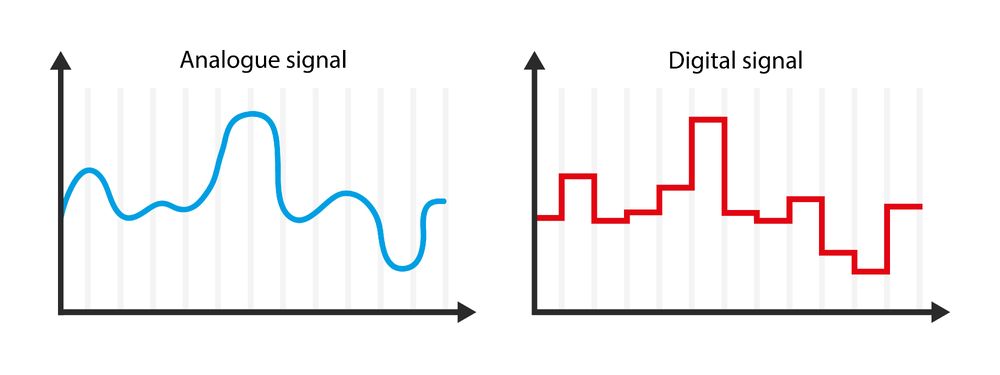8. Digital Mixers
Basics:
Alright, let's dive into the basics of digital mixers. These have been around for a while now, and if you're thinking about buying one, you might need to invest a bit more cash, but it could be worth it. So, what's this "digital" buzz all about? Well, it's all about being super clear and precise, just like how your finger can point to something with laser-like accuracy. But here's the scoop: what we've been calling a "discrete signal" in those regular mixers (the ones we call analogue) is like a wild horse with infinite possibilities. In digital world, it's more like a well-behaved, rule-following signal.
And guess what? The quality of this digital signal stays consistent. Unlike analogue gear where your signal goes through all kinds of changes from input to output, digital mixers rely on a digital converter, some inside processing magic, and how fast it all happens. And let me tell you, not all digital gear is made equal. The big deal here is resolution (bitrate, they call it) and how quickly stuff gets sampled (sampling rate - 44, 48, 96 kHz). The more bits and the faster the sampling, the closer your signal is to the original (you know, the good ol' analogue signal). But just so you know, there are some physics limits to how close you can get...

Conversion of an analog (blue) signal into a digital one (red), sampled over a period of time
Inside the digital realm, your signal gets treated like it's inside a computer. There are fancy algorithms that mess with routing, levels, sound, and all those dynamic bits. And don't worry, you still get to play with faders and knobs, just like on an old-school mixer. But here's the cool part: you can save all your settings, and some digital mixers can even be remotely accessed by a computer.
And here's where digital mixers flex their muscles: everything is storable and reproducible. You can load heaps of effects and dynamics onto each channel, and knobs can do double or triple duty. If you're feeling adventurous, you can dive into menus and tweak individual settings. The modern digital mixer is like a Lego set, you can add more processing power, expand inputs and outputs, and give it a digital makeover with software updates.
But wait, there's more! Digital signals can be sent from A to B with fewer hiccups. Think digital multicore cables, where all your audio channels travel digitally from the stage to the big sound system through a special cable. At the stage, mics and instruments' analogue signals become these neat digital packets. Then, it's just a slim digital cord to the monitor mixer, the PA, or the recording console. No need to digitize the signal a million times. Plus, your recordings stay digital, which is handy.
Now, eventually we would need to change our digital masterpiece back to analogue because, you know, most speakers still have good old paper diaphragms. The thing is, every time we do this conversion, there's a chance we lose some quality. Especially if the converters aren't top-notch.

Mackie DXB 200
Practical Use and Operation:
Alright, let's talk about how you actually use these mixers, whether they're analogue or digital. This is where things get interesting!
First off, when you're working with a digital mixer, you'll notice that not everything is a physical knob right in front of you. It might take some time to get used to the fact that you usually have to select a channel or subgroup first, and then you can tweak specific stuff (like sending sound to an effect) using some buttons or digital menus. It's a bit of a trade-off. This approach takes a bit more time, but it also means the mixer doesn't have to be as massive. This sleek design is super handy in the studio, where time isn't as critical. In a live setting, though, you don't want to be hunting for controls forever. On the flip side, the lighter weight and smaller size of digital mixers are a big win for gigs. Once you've got the hang of it, you can be a live sound ninja. And they often pack integrated effects and dynamics, so you might not need a big ol' side rack filled with gear. Plus, if you're using a digital multicore cable, setting up is a breeze.
Now, let's chat about reliability. Analog mixers have some tricks up their sleeves in case something goes south. You've got different routing options, and if a channel fails, you can switch to a spare one, or even use a recording or subgroup output as a backup. With digital mixers, if something goes dead, it's often game over for the whole console. At a live show, this could mean a sudden and awkward silence, which is a nightmare for everyone involved.
But here's where digital mixers show their true colors: saving and automation. This is their superhero power. Imagine you've painstakingly tweaked 32 channels to perfection, and then someone messes it all up. With analogue, you'd probably need that glass of beer and a smoke to calm your nerves




